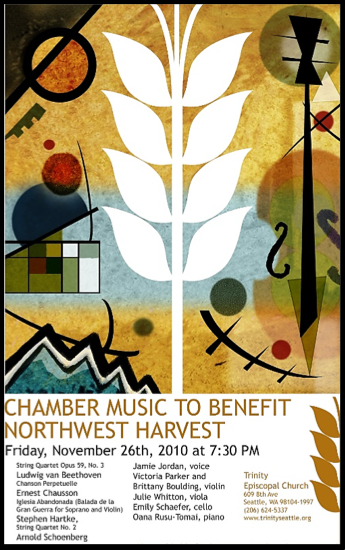Themes of change upon the landscape mixed with agrarian wonder characterized many poems by Pulitzer Prize winning author Howard Nemerov (1920-1991). Although the New York native spent much of his life in academia, he traveled widely through the New England countryside and with publication of his 1955 collection The Salt Garden, Nemerov’s refined, contemplative verse took on more practical tones in defense of the land. Poems like “Midsummer’s Day” and “The Winter Lightning” reflect upon the timelessness of the seasons and consider a consilience with humanity’s ephemeral presence. In “A Harvest Home” an abandoned vehicle stands in a recently harvested field (“So hot and mute the human will / As though the angry wheel stood still / That hub and spoke and iron rim”), while marvelous creatures of the wing appear throughout the day—jays “proclaim” dawn, afternoon crows “arise and shake their heavy wings,” and an owl “complains in darkness.”
John Clement, Bringing in the Sheaves (2005), John Clement Gallery
Color images of “Northwest Drylands” photographer John Clement like May Grain Abound, Wheat Moon, and Bringing in the Sheaves show the influence of two prominent American watercolor artists whose works he has closely studied since starting his career in the 1970s—Winslow Homer and Andrew Wyeth. Although the substantial portion of Homer’s paintings depict realistic Eastern landscapes and ocean scenes, Impressionistic views like Schooner at Sunset captured Clement’s imagination just as they inspired a generation of modern American artists like Wyeth and his father, Nathaniel. Clement studied the watercolors of the younger Wyeth and learned that the drier Pennsylvania prairie and underlying abstractions in paintings like Christina’s World held lessons in originality for photography of the arid Columbia Plateau grainlands. Clement’s unpeopled landscapes, which earned him induction into the Professional Photographers of America International Hall of Fame, typically feature evidence of humanity’s presence—barns and fences, retired farm machinery, and fields of maturing grain. His ideas about the “saturating luminosity” of dawn and dusk suggest affinity with the nineteenth century American Luminists and pioneers of twentieth century color photography whose detailed agrarian views beneath soft, hazy skies engender feelings of tranquility and spiritual appreciation.














